
The Central Pacific Railroad (CPRR) was a rail company chartered by U.S. Congress in 1862 to build a railroad eastwards from Sacramento, California, to complete the western part of the "First Transcontinental Railroad" in North America. Incorporated in 1861, CPRR ceased operation in 1885 when it was acquired by Southern Pacific Railroad as a leased line.
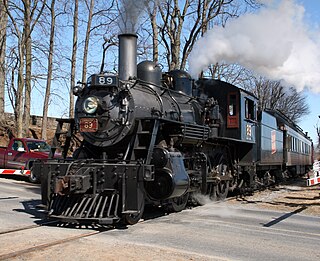
Under the Whyte notation for the classification of steam locomotives, 2-6-0 represents the wheel arrangement of two leading wheels on one axle, usually in a leading truck, six powered and coupled driving wheels on three axles and no trailing wheels. This arrangement is commonly called a Mogul.
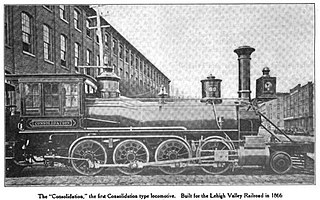
Under the Whyte notation for the classification of steam locomotives, 2-8-0 represents the wheel arrangement of two leading wheels on one axle, usually in a leading truck, eight powered and coupled driving wheels on four axles, and no trailing wheels. In the United States and elsewhere, this wheel arrangement is commonly known as a Consolidation, after the Lehigh and Mahanoy Railroad’s Consolidation, the name of the first 2-8-0.

The EMD FP7 is a 1,500 horsepower (1,100 kW), B-B dual-service passenger and freight-hauling diesel locomotive produced between June 1949 and December 1953 by General Motors' Electro-Motive Division and General Motors Diesel. Final assembly was at GM-EMD's La Grange, Illinois plant, excepting locomotives destined for Canada, in which case final assembly was at GMD's plant in London, Ontario. The FP7 was essentially EMD's F7A locomotive extended by four feet to give greater water capacity for the steam generator for heating passenger trains.

The EMD SW1 is a 600-horsepower (450 kW) diesel-electric switcher locomotive built by General Motors' Electro-Motive Corporation between December 1938 and November 1953. Final assembly was at EMD's plant at LaGrange (McCook) Illinois. The SW1 was the second generation of 3,402 cu in (55.75 L) switcher from EMD, succeeding the SC and SW. The most significant change from those earlier models was the use of an engine of EMD's own design, the then-new 567 engine, here in 600 hp (450 kW) V6 form. 661 locomotives of this design were built, with a gap in production between March 1943 and September 1945 due to World War II.

The St. Louis–San Francisco Railway, commonly known as the "Frisco", was a railroad that operated in the Midwest and South Central United States from 1876 to April 17, 1980. At the end of 1970, it operated 4,547 miles (7,318 km) of road on 6,574 miles (10,580 km) of track, not including subsidiaries Quanah, Acme and Pacific Railway and the Alabama, Tennessee and Northern Railroad; that year, it reported 12,795 million ton-miles of revenue freight and no passengers. It was purchased and absorbed into the Burlington Northern Railroad in 1980. Despite its name, it never came close to San Francisco.

The EMD NW5 was a 1,000 hp (750 kW) road switcher diesel-electric locomotive built by General Motors Electro-Motive Division of La Grange, Illinois between December 1946 and February 1947.

The Central California Traction Company is a Class III short-line railroad operating in the northern San Joaquin Valley, in San Joaquin County, California. It is owned jointly by the Union Pacific and BNSF Railway.

Gov. Stanford is a 4-4-0 steam locomotive originally built in 1862 by Norris Locomotive Works. Following construction, it was disassembled and hauled by the ship Herald of the Morning around Cape Horn to California, then up the rivers aboard the schooner Artful Dodger, arriving in Sacramento on October 6, 1863. With a dedication ceremony that included artillery discharge, it entered service on November 9, 1863, and it was used in the construction of the First Transcontinental Railroad in North America by Central Pacific Railroad bearing road number 1. It was Central Pacific's first locomotive and it is named in honor of the road's first president and ex-California governor, Leland Stanford.

El Gobernador was a 4-10-0 steam locomotive built by Central Pacific Railroad at the railroad's Sacramento, California shops. It was the last of Central Pacific's locomotives to receive an official name and was also the only locomotive of this wheel arrangement to operate on United States rails. At the time it was built, El Gobernador was the largest railroad locomotive ever built. Its name is reminiscent of the railroad's first locomotive, Gov. Stanford, as El Gobernador is Spanish for The Governor. This locomotive is a Mastodon type. Confusingly, this was the unofficial name for an earlier engine, "Mastodon" No. 229, the first successful 4-8-0 ever built. Both engines looked nearly identical, except that El Gobernador was longer and had an additional pair of drivers.

C. P. Huntington is a 4-2-4T steam locomotive on static display at the California State Railroad Museum in Sacramento, California, USA. It is the first locomotive purchased by the Southern Pacific Railroad, carrying that railroad's number 1. The locomotive is named in honor of Collis P. Huntington, the third president of the Southern Pacific Company.
Established in 1908, the Stockton Terminal and Eastern Railroad provides service to several companies around the Stockton area, in San Joaquin County, California.

The Tidewater Southern Railway was a short line railroad in Central California in the United States. For most of its history, it was a subsidiary of the Western Pacific Railroad. It was originally built as an interurban system, connecting to the Central California Traction Company, Western Pacific Railroad, Southern Pacific Railroad and Atchison, Topeka and Santa Fe Railway in Stockton, California. Its mainline went southeast from Stockton to Escalon, California and thence to Modesto, California before splitting into two branches ending at the towns of Turlock and Hilmar. Until the mid-1930s, there were plans to extend the line to Fresno and even toward the Los Angeles area. Today, much of the line is still operated by the Union Pacific Railroad. Of all the former interurban railroads in California, the former Tidewater Southern retains the highest percentage of still operating trackage.
The San Joaquin and Sierra Nevada Railroad was originally built as a 3 ft narrow gauge that ran from Bracks Landing to Woodbridge and Lodi and then east to the Sierra Nevada foothill town of Valley Springs. The railroad was incorporated on March 28, 1882 and construction was completed on April 15, 1885. The railroad was built as a common carrier with copper mining being its primary traffic. The track was built using 35/40 lb steel rails.
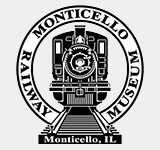
The Monticello Railway Museum is a non-profit railroad museum located in Monticello, Illinois, about 18 miles west of Champaign, IL. It is home to over 100 pieces of railroad equipment, including several restored diesel locomotives and cars.

The Jupiter was a 4-4-0 steam locomotive owned by the Central Pacific Railroad. It made history when it joined the Union Pacific No. 119 at Promontory Summit, Utah, during the Golden Spike ceremony commemorating the completion of the First Transcontinental Railroad in 1869.
The Western Pacific Railroad (1862-1870) was formed in 1862 to build a railroad from Sacramento, California, to the San Francisco Bay, the westernmost portion of the First Transcontinental Railroad. After the completion of the railroad from Sacramento to Alameda Terminal on September 6, 1869, and then the Oakland Pier on November 8, 1869, which was the Pacific coast terminus of the transcontinental railroad, the Western Pacific Railroad was absorbed in 1870 into the Central Pacific Railroad.
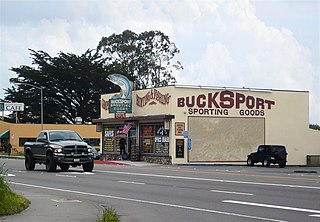
Bucksport was a town in Humboldt County, California. The original location was 2.5 miles (4 km) southwest of downtown Eureka, on Humboldt Bay about 5 miles (8 km) northeast of entrance. at an elevation of 16 feet (4.9 m). Prior to American settlement a Wiyot village named Kucuwalik stood here.
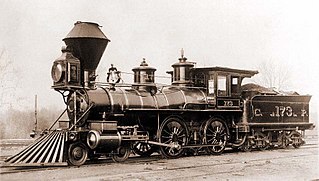
The Central Pacific Railroad number 173 was a 4-4-0 steam locomotive built by Norris-Lancaster for the Western Pacific Railroad in 1864. After its acquisition by Central Pacific, 173 was involved in a bad wreck, lying idle for two years before undergoing a sweeping reconstruction by the line's Sacramento Shops. It subsequently became the prototype for the railroad's engines when the CP began constructing locomotives. The engine was successful, and more engines were built to 173's design.

The Santa Cruz Railroad 3 is a narrow gauge steam locomotive in Washington D.C. It is one of three preserved Baldwin Class 8/18 C 4-4-0 locomotives in the United States, the other two being the North Pacific Coast Railroad No. 12, the "Sonoma" displayed at the California State Railroad Museum, and the Eureka and Palisade Railroad no. 4, the "Eureka" which is privately owned, the latter of which it is the only operable example. It was common practice for American railroads of the 19th century to name their engines after Jupiter, "King of Gods", and other mythological figures to attract attention, thus the engine should not be confused with the engine of Golden Spike fame.

















